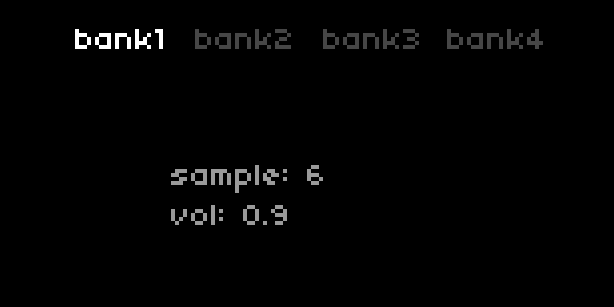Tabs
control
| Syntax | Description |
|---|---|
| UI.Tabs.new (index, titles) | Create a new instance or set of tabs index is the open or active tab: number titles is a list of each tab’s title: table |
| my_tabs:set_index (index) | Set tab index : number |
| my_tabs:set_index_delta (delta, wrap) | Set tab index using delta, with wrapping : number, boolean |
| my_tabs:redraw () | Redraw tab elements |
query
| Syntax | Description |
|---|---|
| my_tabs.index | Returns current index : number |
example

UI = require("ui")
-- create a list of titles
my_titles = {'bank1', 'bank2', 'bank3', 'bank4'}
-- create our banks
banks = {}
for i=1,#my_titles do
banks[i] = {sample = math.random(1,8), vol = math.random(0,100)/100}
end
my_tabs = UI.Tabs.new(1,my_titles) -- create a new instance of tabs
function redraw()
screen.clear()
screen.font_size(8)
my_tabs:redraw() -- redraw tabs
screen.level(8)
screen.move(30,40)
screen.text('sample: '..banks[my_tabs.index].sample)
screen.move(30,50)
screen.text('vol: '..string.format("%.2g",banks[my_tabs.index].vol))
screen.update()
end
function enc(n,d)
if n == 1 then
my_tabs:set_index_delta(d,false) -- change the index, ie the active tab
elseif n == 2 then
banks[my_tabs.index].sample = util.clamp(banks[my_tabs.index].sample + d,1,8)
elseif n == 3 then
banks[my_tabs.index].vol = util.clamp(banks[my_tabs.index].vol + d/100,0,1)
end
redraw()
end
description
Creates a set of tabs with a minimal on-screen UI. The tab titles appear at the top of the screen, and the active tab is highlighted. Note that the length of the titles is limited depending on the number of titles, and vice versa.
UI.Tabs.new returns a table which should be stored in a variable (eg. my_tabsin our example). The various other controls and queries can then be called using the assigned variable in the manner described above.
The UI is drawn using its redraw() function, which needs to be called when there is a change in the instance of tabs or the index.